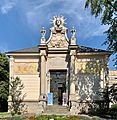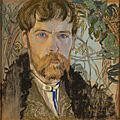Young Poland facts for kids
Young Poland (in Polish: Młoda Polska) is a period modernist of Polish art, literature and music. This period covered about the years since 1890 until 1918. It was one of the effects of the strong opposition to the ideas of the positivism and developed the nature of decadence, of neoromanticism, of symbolism, of impressionism, and of the Art Nouveau.
History
The expression was known after one of the manifestos written by Artur Górski. The manifesto was published in the daily (newspaper) Życie ("Life"), seated in Cracow, in the year 1898, and was immediately accepted in all the parts of the divided Poland, by analogy with other similar expressions as Young Germany, Young Belgium, Young Scandinavia and so on.
Literature
Polish literature of the period was based on two main understandings:
- The first understanding was the usual modernist state of being disappointed by bourgeoisie, its way of life and its culture. The artists who follow this understanding believed also in the decadence, in the end of all the culture, in the conflict between the people and its civilisation, and in the understanding of art as highest value (in Latin: ars gratia artis). Among other writers there are Kazimierz Przerwa Tetmajer, Stanisław Przybyszewski, Wacław Rolicz-Lieder and Jan Kasprowicz.
- The second understanding was the continuation of the romanticism, and for this reason is called neoromanticism. The group of writers which followed this idea was less organized and the writers independently covered a wide area of subjects in their writings: from the sense of the mission of the Polish in the prose of Stefan Żeromski to the social inequality described by Władysław Reymont and Gabriela Zapolska, to criticizing the Polish people and to the history of Poland described by Stanisław Wyspiański.
Other important writers of the period were:
- Wacław Berent
- Jan Kasprowicz
- Jan Augustyn Kisielewski
- Antoni Lange
- Jan Lemański
- Bolesław Leśmian
- Tadeusz Miciński
- Andrzej Niemojewski
- Franciszek Nowicki
- Władysław Orkan
- Artur Oppman
- Włodzimierz Perzyński
- Tadeusz Rittner
- Wacław Sieroszewski
- Leopold Staff
- Kazimierz Przerwa-Tetmajer
- Maryla Wolska
- Tadeusz Boy-Żeleński
Music
In music, the expression Young Poland is put into use to an informal group of composers which include Karol Szymanowski, Grzegorz Fitelberg, Ludomir Różycki and probably also Mieczysław Karłowicz. This group worked under the strong influence of the neoromanticism of the music, and especially of composers from another countries as Richard Strauss and Richard Wagner. The composers would be also strong links with the The Five, a group of composers Russian which included Modest Musorgski, Alexander Borodin and Nikolai Rimsky-Korsakov.
Art
In the period of the Young Poland there were not any great artistic currents in Polish art. The painters and the sculptors attempted to continue in the romantic tradition, in bringing new ways of expression already popular in another countries. The more influential current was the Art Nouveau, even if the Polish artists started attempting also new forms of national style. The sculptura just like the painture of the period were strongly influenced by all the forms of the symbolism.
Main artists of the period
- Olga Boznańska
- Konstanty Brandel
- Xawery Dunikowski
- Julian Fałat
- Jacek Malczewski
- Józef Mehoffer
- Józef Pankiewicz
- Ferdynand Ruszczyc
- Jan Stanisławski
- Władysław Ślewiński
- Wojciech Weiss
- Leon Wyczółkowski
- Stanisław Wyspiański
- Jan Bukowski
Images for kids
-
Palace of Art, also known as "Secession" headquarters of the Kraków Society of Friends of Fine Arts, in Krakow Old Town
-
Stanisław Wyspiański self-portrait in soft pastel, 1902
See also
 In Spanish: Joven Polonia para niños
In Spanish: Joven Polonia para niños





